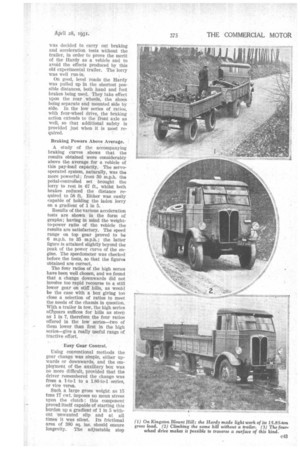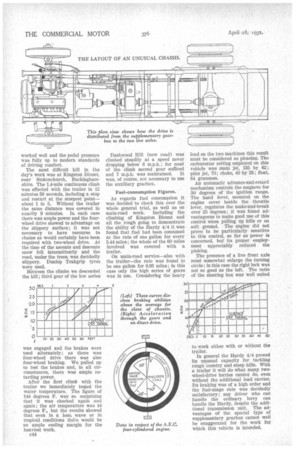A Vehicle of Ambitious Performance
Page 64

Page 65

Page 66

If you've noticed an error in this article please click here to report it so we can fix it.
POSSIBLY no group of men has a wider experience of making vehicles for difficult work than those connected with Hardy Motors, Ltd., of Slough. For many years machines with all wheels available for driving have been produced from the factory, and the 4/4 model, to which this test report refers, is one of the latest. It embodies units of A.E.C. make, the Hardy concern being allied to the Associated Equipment Co., Ltd., of Southall. The chassis in question was first described by The Commercial Motor in the issue dated December 2nd, 1930.
Prinapal Points in Design.
In brief the chassis incorporates an A.E.C. four-cylindered engine (offset in the frame) driving through an A.E.C. clutch and fourspeed gearbox to the special Hardy supplementary gearbox. This gives two speeds, direct (1 to 1) or 1.86 to 1, thus doubling the number of forward and reverse ratios afforded by the normal box. The auxiliary contains three shafts and five pinions; if desired a take-off, capable of transmitting full engine power, can be installed in this gearbox, operating through any ratio in the main box. There is also available„a small take-off on the side of the main gearbox casing; it runs at approximately half engine speed.
The principal point of novelty about the transmission lies in the arrangement of two-wheel or fourwheel drive. When the separate lever controlling the auxiliary gearbox is in the "high series" position 01.2 the drive to the front wheels automatically goes out of action, the front-axle worm and wheel simply rotating idly. When the lever is moved to the "low series" position the power is automatically distributed to the two live axles. The pots of both axles are offset, that of the rear one being to the left of the centre line, whilst the front axle hiss its worm and wheel set to the right of the centre.
Wide Range of Gear Ratios.
The normal first gear is 31.68 to 1, but the auxiliary box reduces this to 58.92 to 1—nearly twice as low, so that the range of the vehicle is enormously enhanced. If the large torque exerted in low gear were carried through only one axle it . might give rise to transmission trouble; by the Hardy method two axles share the burden in very heavy ;oing, but the normal work is carried out with but fractionally greater friction than would be the case with a two-wheel-drive chassis.
A feature of the 4/4 Is its ability to haul a trailer weighing up to 7 tons gross. It may be used, therefore, as a lorry capable of tackling freak surfaces, such as are encountered in building sites or dumps, whilst it is equally at home on main roads. Even when a trailer is added the surface traversable can be much worse than that over which a twowheel-drive lorry alone can be expected to run with safety.
On the day of the test the machine was laden with metal scrap. as was the trailer, which throughout the trial carried •a brakesman. It was decided to carry out braking and acceleration tests without the trailer, in order to prove the merit of the Hardy as a vehicle and to avoid the effects produced by this old experimental trailer. The lorry was well run-in.
On good, level roads the Hardy was pulled up in the shortest possible distances, both hand and foot brakes being used. They take effect upon the rear 'wheels, the shoes being separate and mounted side by side. In the low series of ratios, with four-wheel drive, the braking action extends to the front axle as well, so that additional safety is provided just when it is most required.
Braking Powers Above Average.
A study of the accompanying braking curves shows that the results obtained were considerably above the average for a vehicle of this pay-load capacity. The servooperated system, naturally, was the more powerful; from 30 m.p.h. the pedal-controlled set brought the lorry to rest in 67 ft., whilst both brakes reduced the distance required to 58 ft. Either was easily capable of holding the laden lorry on a gradient of 1 in 5.
Results of the various acceleration tests are shown in the form of graphs; having in mind the weightto-power ratio of the vehicle the results are satisfactory. The speed range on top gear proved to be 6 m.p.h. to 35 m.p.h. • the latter figure is attained slightly beyond the peak of the power curve of the engine. The speedometer was checked before the tests, so that the figures obtained are correct.
The four ratios of the high series have been well chosen, and we found that a change downwards did not involve too rapid recourse to a still lower gear on stiff hills, as would be the case with a box giving too clOse a selection of ratios to meet the needs of the chassis in question. With a trailer in tow, the high series ofhears suffices for hills as steep as 1 in 7, therefore the four ratios offered in the low series—two of them lower than first in the high series—give a really useful range of tractive effort.
Easy Gear Control. • Using conventional methods the gear change was simple, either upwards or downwards, and the employment of the auxiliary box was no more difficult, provided that the driver remembered the change was from a 110-1 to a 1.86-to-1 series, or vice versa.
Such a large gross weight as 15 tons 17 cwt. imposes no mean stress upon the clutch this component proved itself capable of starting this burden up a gradient of 1 in 5 without unwanted slip and at all times it was silent. Its frictional area of 380 sq. ins, should ensure longevity. The adjustable stop worked well and the pedal pressure was fully up to modern standards of driving comfort.
The most difficult hill in the day's work was at Kingston Blount, near Stokenchurch, Buckinghamshire. The 1.4-mile continuous climb was effected with the trailer in 12 minutes 39 seconds, including a stop and restart at the steepest point— about 1 in 5. Without the trailer the same distance was covered in exactly 9 minutes. In each case there was ample power and the fourwheel drive showed to advantage on the slippery surface; it was not necessary to have recourse to chains as would certainly have been required with two-wheel drive. At the time of the ascents and descents snow fell intermittently and the road, under the trees, was decidedly slippery. Dunlop Trakgrip tyres were used.
l3'etween the climbs we descended the hill ; third gear of the low series was engaged and the brakes were used alternately ; as there was four-wheel drive there was also four-wheel braking. We pulled up to test the brakes and, in all circumstances, there was ample retarding power.
After the first climb with the trailer we immediately tested the water temperature. The figure of 144 degrees F. was so surprising that it was checked again and again; the air temperature was 44 degrees F., but the results showed that even in a heat. wave or in tropical conditions there would he an ample cooling margin for the heaviest work.
c44 Dashwood Hill (new road) was climbed steadily at a speed never dropping below 6 m.p.h.; for most of the climb second gear sufficed and 7 m.p.h. was maintained. It was, of course, not necessary to use the auxiliary gearbox.
Fuel-consumption Figures.
'As regards fuel consumption it was decided to check this over the whole general trial, as well as on main-road work. Including the climbing of Kingston Blount and all the rough going to demonstrate the ability of the Hardy 4/4 it was found that fuel had been consumed at the rate of one gallon for every 5.44 miles ; the whole of the 60 miles involved was covered with a trailer.
On main-road service—also with the trailer—the rate was found to be one gallon for 6.93 miles ; in this case only the high series of gears was in use. Considering the heavy load on the two machines this result must be considered as pleasing. The carburetter setting employed on this vehicle was main jet, 135 by 62; pilot jet, 70; choke, 40 by 29; float, 64 grammes.
An automatic advance-and-retard mechanism controls the magneto for 30 degrees of the ignition' range. The hand lever, mounted on the engine cover beside the throttle lever, regulates the make-and-break over 25 degrees; it was found advantageous to make good use of this control when pulling up hills or on soft ground. The engine did not prove to be particularly sensitive to this control, so far as power is concerned, but its proper employment appreciably reduced the pinking.
The presence of a live front axle must somewhat enlarge the turning circle ; in this ease the right lock was not so good as the left. The ratio of the steering box was well suited to work either with or without the trailer.
In general the Hardy 4/4 proved Its unusual capacity for tackling rough 'country and steep hills. With a trailer it will do what many twowheel-drive lorries cannot do, even without the additional load carrier. Its braking was of a high order and the fuel-usage rate was decidedly satisfactory ; any driver who can handle the ordinary lorry can handle the Hardy, despite the additional transmission unit. The advantages of the special type of supplementary gearbox cannot well be exaggerated for the work for which this vehicle is intended.












































































































